Per la maggior parte della storia registrata, le persone usavano solo il rabarbaro in medicina. Nativo della Cina, si pensa che Marco Polo abbia riportato il rabarbaro dai suoi viaggi.
Rheum rhabarbarum non è stato utilizzato come fonte di cibo fino alla fine del 1700. La sua prima menzione registrata è come pianta da torta.
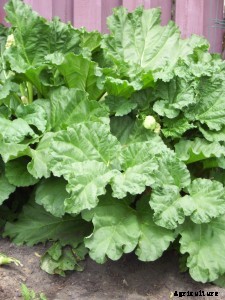
Il rabarbaro è stato ampiamente piantato dai pionieri negli Stati Uniti, e molte di quelle piantagioni originali sopravvivono oggi nelle nostre città del nord.
Hardy nelle zone USDA da 3 a 8, il rabarbaro cresce da 2 a 3 piedi di altezza, a seconda della varietà. Ha bisogno di temperature inferiori a 40 gradi per rompere la sua dormienza invernale e iniziare una nuova crescita in primavera.
Pianta il rabarbaro in pieno sole in un ricco terreno da giardino. Distanzia le piante da 3 a 4 piedi di distanza in file di 3 piedi di distanza. Le piante diventeranno più piccole e saranno meno produttive se piantate più vicine tra loro. Posiziona la corona a circa 2 pollici sotto la superficie del terreno:annaffia bene.
Fornisci acqua al rabarbaro appena trapiantato per il suo primo anno nel tuo giardino. Da allora in poi resisterà abbastanza bene alla siccità.
Non raccogliere il rabarbaro il primo anno in cui lo pianti. Come gli asparagi, ha bisogno di mettere tutta la sua energia nella costruzione di un forte apparato radicale il primo anno.
Raccogliere il secondo anno con parsimonia. Raccogli solo steli spessi almeno un pollice. Durante il suo terzo anno, raccolto per circa un mese in primavera. Successivamente, raccogliere i gambi man mano che maturano per l'intera stagione del rabarbaro, che dura circa sei settimane da quando i primi steli sono pronti per la raccolta all'inizio della primavera.
Taglia i gambi sulla linea del terreno o afferra uno stelo vicino alla superficie del terreno e ruotalo lontano dalla corona.
Il rabarbaro è la pianta della torta; è usato principalmente come frutta nelle torte, patatine, composte, e marmellate. Fatto in una salsa liscia, è anche un buon compagno per i frutti di mare.
Uno dei miei primi ricordi d'infanzia è quello di cogliere un gambo di rabarbaro fresco dall'orto, immergendolo nello zucchero, e mangiarlo crudo. Certo, questo prima che gli scienziati scoprissero che lo zucchero fa male.
Pratico l'amnesia selettiva quando si tratta di tali scoperte.
Uno dei miei primi ricordi è la raccolta di piselli freschi in giardino, poi toglierli dal baccello e mangiarli crudi.
Quelli erano i tradizionali piselli inglesi coltivati da mia madre. Non ho mai coltivato piselli inglesi; Scelgo di usare lo spazio per coltivare Oriental Snow Peas o Sugar Snap Peas.
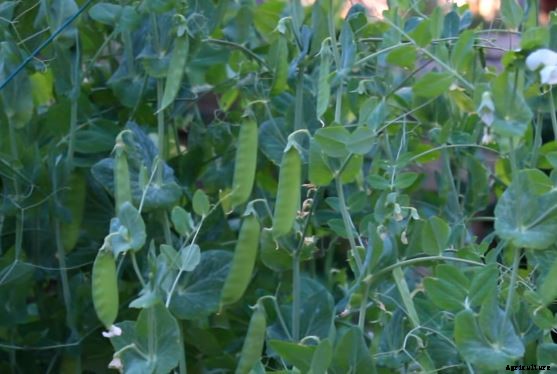
Lo scorso inverno, mentre organizzo ed elimino la mia raccolta di semi, Mi sono imbattuto in due pacchetti di piselli, uno ciascuno di Snow e Sugar Snap. Avevo scritto sul pacco che li avevo raccolti dal mio giardino nel 2002, che è stato l'ultimo anno che ho avuto un grande orto, per infortunio e malattia.
Essendo un giardiniere parsimonioso, Non volevo buttarli via. Li metto in un germogliatore pensato per coltivare erba medica o altri piccoli germogli per la cucina. Come puoi vedere dalla foto sopra, entro un paio di giorni, avevano germogliato.
Solo dieci semi di pisello sono germogliati, e tutti tranne uno hanno rotto il terreno nel giardino. Per quanto riguarda i piselli Sugar Snap, solo otto germogliati e finora, uno o due hanno rotto il terreno.
Pisum sativum var. macrocarpo, o Piselli di neve, è stato trovato in siti archeologici cinesi ed egiziani risalenti al 12, 000 anni fa. Si pensa che il nome derivi dalla tinta biancastra riflessa dai baccelli alla luce del sole o che spesso si accrescano durante le nevicate di fine stagione.
I piselli non sono esigenti sul tipo di terreno in cui crescono, purché ben drenato; i semi di pisello marciranno se piantati in un terreno che non drena bene.
Pianta i piselli all'inizio della primavera non appena puoi lavorare il terreno. Pianta a circa due pollici di distanza e profonda circa un pollice. Quando circa due pollici di altezza, sottile per stare da tre a quattro pollici di distanza.
Fornisci un traliccio per far arrampicare i tuoi piselli Snow o Sugar Snap. Diventeranno molto più alti della loro controparte inglese di piselli da giardino.
I piselli sono un legume, e come tutti i legumi, fissano l'azoto nel terreno. Cosa significa questo per il tuo giardino? Le piante prendono l'azoto dall'aria (come per magia) e lo trasudano attraverso le loro radici, quindi "fissandolo" nel terreno. Questo è più vantaggioso per le colture che amano molto azoto, come verdure o mais.
I piselli smettono di produrre quando arriva il caldo estivo, quindi sono un raccolto perfetto per la semina in successione. Nel mio giardino quest'anno, Pianterò il mais proprio accanto al recinto dove si arrampicheranno i piselli; rimarranno lontani l'uno dall'altro perché il mais non sarà cresciuto abbastanza da affollare i piselli prima che i piselli abbiano finito di produrre.
Una cosa importante da ricordare sui piselli:dopo che smettono di produrre quando arriva il caldo, tagliare le viti a livello del suolo e lasciare le radici nel terreno. Continueranno a marcire e ad aggiungere azoto al terreno.
Sono sicuro che quest'anno prenderò solo un paio di pasti dalla mia dozzina di piante di piselli, ma produrranno anche semi da piantare l'anno prossimo.
La mia ricerca rivela che la nuova crescita sulle punte dei piselli viene spesso tagliata e saltata in padella come una verdura nei piatti orientali. Lo proverò sicuramente come nuovo ortaggio primaverile quest'anno.
Vinca minor è una delle piante rare il cui nome latino è usato come nome comune. Chiamato anche mirto strisciante o pervinca, vinca è un tappezzante perenne sempreverde. Fiorisce in primavera con affascinanti fiori viola che ricoprono la pianta.
Vinca è originaria dell'Europa settentrionale e centrale ed è resistente nelle zone da 3 a 9 dell'USDA. In alcune aree, può essere considerato invasivo.
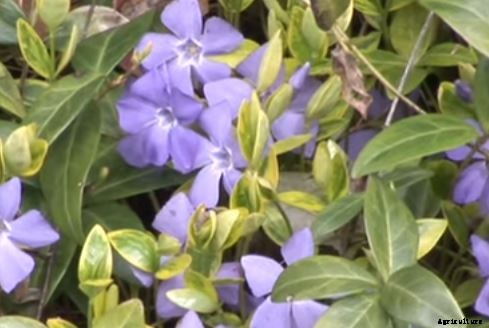
Vinca preferisce crescere in piena ombra al sole parziale. Le foglie svaniranno, e la pianta sarà poco brillante se coltivata in pieno sole.
Piantato su una collina, vinca aiuterà a prevenire l'erosione. Le sue radici si aggrapperanno al suolo, ed eliminerà quasi tutte le erbacce. Si espanderà e ti fornirà fiori viola in primavera e fogliame sempreverde per il resto dell'anno.
Vinca crescerà e prospererà anche sotto un albero sempreverde.
Space vinca trapianta a circa 18 pollici di distanza in terreno ricco in ombra parziale o totale. Innaffia bene il primo anno dopo la semina, e successivamente, vinca si prenderà cura di se stessa.
Aspettati che il tuo groundcover di vinca cresca e si diffonda in una stuoia larga da 2 a 3 piedi e alta da 6 a 12 pollici.
Il folklore ci dice che la vinca dovrebbe ispirare l'amore e significare i primi ricordi o piaceri della memoria.
Quali piacevoli ricordi ti evoca vinca?
Un cespuglio di ghirlande da sposa, o spirea, è un arbusto a fioritura primaverile piantato nelle città di tutto il mondo.
Crescono bene in quasi tutti i terreni e, una volta stabilito, tollerare la siccità e l'abbandono.
I loro delicati fiori bianchi su rami aggraziati sbocciano in modo affidabile ogni primavera.
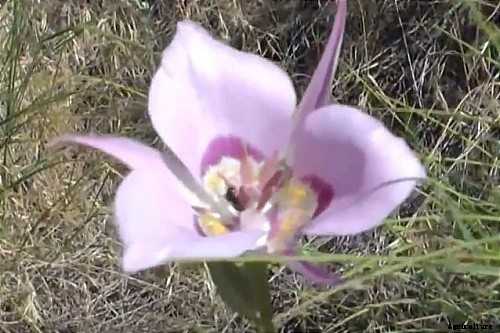
Pianta la corona nuziale a fioritura primaverile in ombra parziale. Potare leggermente subito dopo che i fiori appassiscono. Fioriranno l'anno prossimo su legno che cresce quest'anno, quindi pota con parsimonia.
Il classico cespuglio di ghirlande da sposa è Spirea Vanhoutte. Questa varietà è stata ampiamente piantata negli Stati Uniti per almeno un centinaio di anni. Cresce da 6 a 8 piedi di altezza e produce fiori bianchi puri a fine maggio e inizio giugno.
I suoi fiori sembrano dei mini-bouquet. Per secoli sono stati attorcigliati su se stessi per realizzare ghirlande o bouquet per matrimoni. Il suo nome latino, Spirea, deriva da un'antica parola greca che significa contorto o a spirale.
La corona nuziale nella foto sta crescendo nel cortile di un condominio abbandonato. Si trova parzialmente all'ombra di un acero, e l'erba nel cortile è alta fino al ginocchio. Ancora, fiorisce come se fosse curato da un giardiniere coscienzioso.
Ogni giardino ha bisogno di poche piante che richiedono poca manutenzione.
Le spugnole sono lo sfuggente fungo selvatico che compare in primavera nei boschi del Maine, sud alle aree settentrionali del profondo sud, da ovest a nord del Texas e dell'Oklahoma, ea nord nel Minnesota con alcuni avamposti nei Dakota.
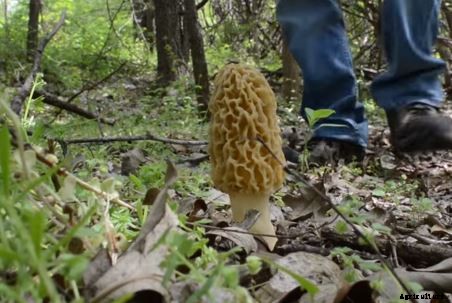
Se non hai mai assaggiato una spugnola, è difficile capire la seria ossessione che i cacciatori di spugnole hanno nel trovare queste prelibatezze selvatiche.
L'ultima primavera, Ne ho trovata una nel mio cortile in mezzo alla città. Questa primavera, mio figlio ha sviluppato l'ossessione di trovarli. Raramente ho visto una tale unicità di intenti e attaccamento ad esso. Abbiamo cercato per la maggior parte della settimana e ne abbiamo trovati solo tre piccoli.
Ieri ha preso suo figlio ed è uscito lungo le rive del Mississippi vicino a St. Paul e ha trovato una dozzina di fornai. Punto!
Ha scattato la foto sopra in situ di un paio di spugnole che hanno trovato.
Mio figlio ha preparato la pasta con il sugo da un barattolo per loro due per cena. Ha infilato nella salsa una spugnola tagliata a dadini, e suo figlio lo dichiarò delizioso. Solo allora il bambino fu informato che la salsa conteneva spugnole.
Da allora il figlio del figlio ha deciso che gli piacciono le spugnole.
Abbiamo deciso di asciugare delle spugnole e usarle per fare un contorno o un antipasto da servire a Natale. Abbiamo anche deciso che ci piacerebbe farne una tradizione annuale.
E sono stato informato che la caccia alle spugnole di quest'anno non è ancora finita.
Questi sono i miei ragazzi.
Il mughetto è uno dei tanti profumatissimi, fiori che sbocciano primaverili. Il suo nome latino, Convallaria majalis, deriva dal latino Corvallis, "Valle, ” e majalis, "Fioritura di maggio". È il fiore ufficiale della nascita di maggio.

Mi sono imbattuto in una macchia di quelli rosa meno comuni (Convallaria majalis Rosea) e mi sono fermato a fare una foto. Il giardiniere mi ha visto e ha insistito per darmene un po' per il mio giardino. Li ho piantati in un letto che fa ombra per parte della giornata.
I mughetti preferiscono una posizione ombreggiata che riceve solo poche ore di sole ogni giorno. A loro piace il terreno umido ma non amano l'acqua stagnante. Assicurati che l'area in cui li pianti sia ben drenata, e non c'è acqua si siede da allora in poi una pioggia.
Coltiva il mughetto da "semi, ” che sono piccoli bulbi che si formano sottoterra insieme alle radici. Si diffondono facilmente e riempiranno un'area in pochi anni.
Pianta i semi a 4-5 pollici di distanza l'uno dall'altro in umido, suolo fertile. Concimare con un fertilizzante granulare in primavera e pacciamare con terriccio fogliare in autunno. Oltre a quello, i tuoi mughetti si prenderanno cura di se stessi.
Dividili ogni cinque anni, quindi non si soffocano a vicenda. Fallo all'inizio dell'autunno. Scava l'intero letto. Taglia le radici in modo che ci sia solo un seme per pianta. Ripiantare a 4-5 pollici di distanza in tutte le direzioni e annaffiare bene. Nel tardo autunno, pacciamare il letto con foglie di muffa o foglie autunnali. Rimuovere il pacciame all'inizio della primavera.
Raccogli i mazzi di fiori dopo che le prime "campane" si sono aperte, come quello in foto. Quel modo, i boccioli vicino alla parte superiore dello stelo del fiore avranno maggiori probabilità di aprirsi in casa.
Un piccolo bouquet di mughetti profumerà un'intera stanza. Il loro affascinante, i boccioli di piccole dimensioni sono perfetti per piccoli vasi posizionati sui comodini o sulla toeletta del bagno.
Se hai una patch grande e abbastanza pazienza, puoi anche asciugarli per usarli in pot-pourri. I fiori secchi manterranno il loro profumo per molti anni.
Leggi anche:Gigli recisi o morti quando hanno finito di fiorire.
I bottoni di laurea sono popolari come piante da giardino e fiori recisi. Originariamente trovato allo stato selvatico nei campi di grano d'Europa, Centaurea cyanus ora cresce spontaneamente in tutto l'emisfero settentrionale.
Il loro colore originale è il blu (come denota il suo secondo nome, ciano), ma ora sono disponibili in marrone scuro, rosso, rosa, e bianco. I bottoni di Bachelor sono anche comunemente chiamati "fiordalisi" o "bluebottles".
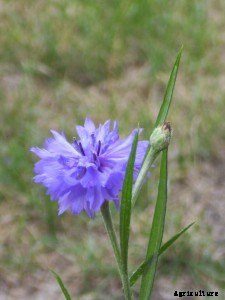
Crescono in tutti i tipi di terreno ma preferiscono il pieno sole. Di solito vengono coltivati da seme e non sono comunemente disponibili come trapianti di partenza. I fiordalisi si ri-seminano abbastanza facilmente. Lasciati a se stessi, emergeranno nella stessa area generale anno dopo anno.
I pacchetti di semi consigliano di seminare direttamente circa due settimane prima dell'ultima gelata primaverile media. Nel mio giardino, i semi caduti l'anno precedente iniziano a spuntare almeno un mese prima della nostra gelata media dell'ultima primavera.
In ogni caso, piantare i semi a circa 1/4 di pollice di profondità e mantenerli umidi fino alla germinazione, in circa 7-14 giorni. Sottili per stare da 8 a 12 pollici di distanza quando sono alti circa 3 pollici.
I loro fiori sono commestibili e hanno un sapore simile ai chiodi di garofano con un po' di dolce e piccante. Il loro colore blu brillante li rende ideali come decorazioni per torte estive. Aggiungili a zuppe e insalate fredde estive.
Trasformato in un decotto, i fiori di fiordaliso sono efficaci nel trattamento delle infezioni agli occhi, come la congiuntivite. Un decotto è anche usato come lavaggio per ravvivare gli occhi stanchi. In erboristeria, i fiordalisi sono noti per le loro proprietà curative.
I fiordalisi sono anche usati come ingrediente nel tè, inclusa la famosa miscela Lady Grey. I loro fiori blu venivano usati come colorante alimentare e pigmento per i colori ad acquerello. Diverse nazioni e cause lo hanno adottato come simbolo del loro orgoglio collettivo.
In un'epoca in cui i fiori erano usati come simboli, gli uomini disponibili li indossavano come fiore all'occhiello. Questa è molto probabilmente l'origine del loro nome comune più popolare. "bottoni da scapolo".
Le piante di ibisco tropicale sono disponibili nei garden center ogni primavera. Quando l'estate è finita, questa varietà tropicale, Hibiscus rosa Sinensis, finisce nella spazzatura o nel cumulo di compost; non sono abbastanza resistenti per sopravvivere all'inverno a nord dei tropici. E non molte persone hanno le condizioni giuste nelle loro case per svernare le piante al chiuso, o.
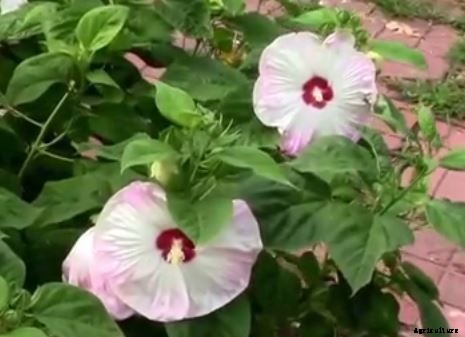
Sapevi che esiste un ibisco resistente? Il suo nome latino è Hibiscus moscheutos, ed è comunemente chiamato "malva". Loro sono, Certo, imparentato con l'ibisco tropicale ma originario del Nord America. Hanno i fiori più grandi di tutti gli ibischi, alcuni sono larghi dodici pollici.
Gli Hibiscus moscheutos sono resistenti in modo affidabile alla zona 4 dell'USDA, e con una protezione invernale extra, Zona 3. Sebbene abbiano steli legnosi, sono considerati piante perenni poiché muoiono completamente a terra in inverno.
L'ibisco resistente è una delle ultime piante che iniziano a crescere in primavera. Spesso sarà fine maggio o inizio giugno prima che gli steli inizino a crescere; non rinunciare a loro troppo presto. Fioriranno a luglio e continueranno a fiorire fino al gelo.
Pizzica le punte in crescita quando i rami sono alti circa un piede. Ciò incoraggerà la pianta a ramificarsi e a produrre ancora più fiori. Non è insolito che un robusto ibisco di malva produca oltre cento fioriture a stagione.
Pianta l'ibisco resistente in pieno sole in un terreno che trattiene molta umidità. Questa è una pianta che crescerà bene in ambienti pesanti, terreno umido. Mantenere ben irrigato durante la stagione di crescita, e il tuo robusto ibisco continuerà a produrre fiori anche nella parte più calda dell'estate.
Quando la pianta viene uccisa dal gelo, tagliare i rami a pochi centimetri dal suolo e pacciamare bene prima che arrivi il gelo costante.
Hibiscus moscheutos crescerà anche in condizioni simili a paludi o paludi. Sono ottimi candidati per aree basse con scarso drenaggio o giardini di zone umide.
L'ibisco resistente cresce rapidamente fino a un'altezza di circa due piedi. Fanno ottime siepi estive, in rapida crescita per definire una “stanza” all'aperto o un giardino speciale.
E sono perenni, quindi non devi piantarli ogni anno.
Gli alberi di ginkgo sono fossili viventi che non sono collegati a nessuna pianta vivente. I reperti fossili di specie correlate terminano dopo il Pliocene ovunque tranne che in una piccola area della Cina centrale.
L'albero del ginkgo vive per centinaia, a volte migliaia di anni. Gli esemplari stanno crescendo vicino ai monasteri in Cina che si ritiene siano 1, 500 anni. Altri esemplari in Cina sono noti per essere più di 3, 000 anni.
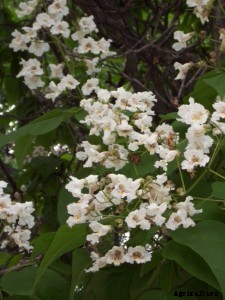
Quattro alberi di ginkgo Biloba sono sopravvissuti alla bomba nucleare di Hiroshima e oggi sono vivi in quella città.
Sono tra i più duri, alberi più resistenti in vita oggi e sono ampiamente piantati nelle aree urbane in tutto il Nord America. Pochi parassiti o malattie li infastidiscono, e possono crescere fino a oltre cento piedi di altezza.
Il loro unico aspetto negativo è un odore fetido associato ai loro baccelli, che può odorare di burro rancido o addirittura di feci.
L'albero del ginkgo è dioico, il che significa che produce piante sia maschili che femminili. Poiché le femmine producono i baccelli puzzolenti, le talee degli alberi maschi vengono innestate sulle piantine e vengono piantate più spesso delle femmine. Fioriscono ancora ma non producono semi.
L'albero del ginkgo diventa giallo brillante in autunno. Hanno una qualità insolita in quanto le loro foglie ingialliscono e cadono entro un breve periodo di 10-15 giorni.
Gli alberi di ginkgo crescono in pieno sole fino all'ombra parziale e cresceranno bene praticamente in qualsiasi tipo di terreno, purché sia adeguatamente drenato. La loro forma colonnare e l'abitudine di crescita eretta li rendono naturali come alberi da ombra piantati lungo le strade della città nelle zone USDA da 3 a 8.
Fioriscono a fine giugno qui nella Zona 4, e le loro fioriture durano solo pochi giorni. La foto sopra è stata scattata a metà estate, proprio quando i fiori cominciavano a sbiadire.
Le Susan dagli occhi neri sono un fiore di campo americano originario delle praterie occidentali. Sono una delle prime piante a iniziare a crescere su terreni che sono stati bonificati.
Rudbeckia hirta è il loro nome latino, anche se spesso vengono confusi con altre varietà.
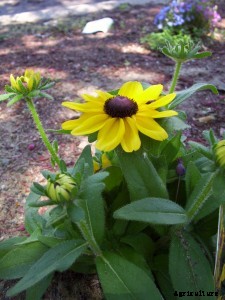
Una cosa che li rende diversi dalla maggior parte degli altri fiori di campo è che non hanno profumo. C'è anche pochissima storia o folklore associati alle Susan dagli occhi neri, molto probabilmente perché non è noto alcun uso medicinale.
Le Susan dagli occhi neri crescono meglio in pieno sole, ma non hanno bisogno di un terreno super fertile per crescere bene. Se il terreno è troppo ricco, la produzione di fiori ne risentirà.
Puoi iniziare le Susan dagli occhi neri dal seme sia all'interno che seminando direttamente in giardino. Pianta i semi all'aperto all'inizio della primavera non appena le temperature superano in modo affidabile i 60 gradi. Quando le piantine sono alte circa tre pollici, magro, quindi stanno a circa 1 1/2 piedi di distanza. Fioriranno il primo anno se iniziati abbastanza presto.
Sono disponibili anche in primavera come piante da aiuola. Rimuovere eventuali fioriture sui trapianti. Ciò incoraggerà le piante a sviluppare un forte apparato radicale e ti ricompenserà con più fiori più avanti in estate.
Distanziali di circa 1 1/2 piedi l'uno dall'altro e innaffia finché non si stabilizzano. Una volta che stanno crescendo attivamente nel tuo giardino, le Susan dagli occhi neri crescono abbastanza bene senza annaffiature aggiuntive.
Dividili circa ogni quattro o cinque anni, o quando noti che i fiori stanno diventando più piccoli. testa morta, o togliendo i fiori spenti, aumenterà il numero di fioriture e la stagione di fioritura.
Le Susan dagli occhi neri sono una pianta perenne a bassa manutenzione che resiste facilmente alla siccità e all'abbandono.
Rose, che necessitano di abbondanti quantità d'acqua e di cure attente, stanno crescendo in un abbandonato, parcheggio recintato.
La cosa sorprendente per me è che abbiamo appena avuto la terza primavera più secca nella nostra zona da quando sono iniziate le registrazioni del tempo più di cento anni fa.
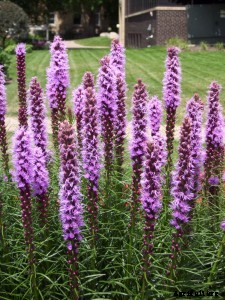
L'autunno scorso, un fast-food del quartiere chiuso misteriosamente nel bel mezzo della giornata lavorativa. Hanno messo l'indirizzo del loro ristorante più vicino sul tendone, sbarrato le finestre, e metti una rete metallica intorno all'intera proprietà.
Quasi nove mesi dopo, Non ho potuto fare a meno di notare le rose che crescono nell'ex parcheggio paesaggistico. Ho scattato la foto sopra attraverso la rete metallica eretta per tenere lontani i trasgressori.
Apparentemente, il tessuto paesaggistico nel letto di rose trattiene abbastanza erbacce per consentire alla rosa di crescere.
Ricorda le molte società di rose che cercano attivamente e salvano vecchie varietà di rose. Molte rose antiche crescono spontaneamente senza l'assistenza dei giardinieri. Queste rose si trovano in lotti liberi, cascine abbandonate, e antichi cimiteri. Documento delle società di conservazione delle rose antiche, prelevare talee e propagare le rose antiche in modo che non vengano perse per noi.
L'obiettivo della maggior parte di queste società è quello di raccogliere le cosiddette rose "vecchie", quelle sviluppate prima che i geni delle rose cinesi venissero allevati nel pool genetico. Sebbene questo possa essere l'obiettivo principale dei soccorritori di rose antiche, Scommetto che molte oscure varietà di rose "moderne" hanno trovato la loro strada nella protezione e nella coltivazione di queste organizzazioni.
Un amante delle rose non rifiuterà di far crescere una bella, varietà di rose sconosciuta semplicemente perché non è abbastanza vecchia.
Dopotutto, "una rosa è una rosa".
Agerato, chiamati anche “fiori di filo interdentale, ” sono originarie dell'America Centrale e del Messico, sebbene quattro specie siano identificate come originarie degli Stati Uniti.
La varietà più comunemente coltivata è Ageratum houstonianum. Ageratum viene dal greco “a geras, ” che significa “non invecchiamento, ” molto probabilmente riferito alla longevità dei fiori.
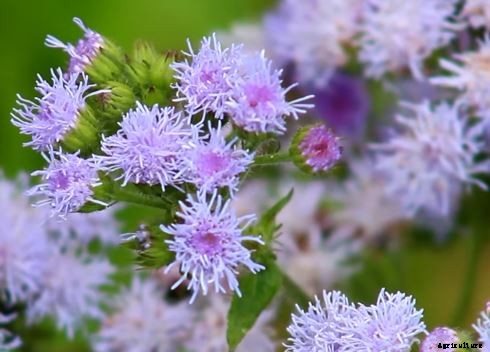
I fiori sono soffici e disponibili in lilla, rosa o bianco, e il sempre popolare blu lavanda. Si diffondono in ombrelle composte, dando loro un aspetto soffice, una specie di pompon appiattiti.
Poiché la maggior parte delle varietà cresce a meno di un piede di altezza, L'ageratum è popolare come piante da bordatura o nascosto in contenitori o cesti appesi. Fioriscono abbondantemente da giugno fino a quando non vengono uccisi dal gelo. Sebbene preferiscano il pieno sole, sono più felici con un po' di ombra durante le parti più calde dell'estate.
Puoi seminarli direttamente in giardino, ma non fioriranno fino a metà estate passata. Per le prime fioriture, avviali in casa da 6 a 8 settimane prima dell'ultimo gelo primaverile. I semi hanno bisogno di luce per germogliare, quindi cospargerli sul mezzo di partenza del seme e premere leggermente con la mano.
Innaffia dal basso mettendo i vasi di avviamento in un contenitore più grande contenente circa un pollice di acqua. Rimuovere i vasi dall'acqua quando la superficie del mezzo di partenza del seme sembra umida. Ciò impedisce ai semi di essere lavati nelle profondità del terreno. Lasciare scolare l'acqua in eccesso, e non lasciare che le pentole di avviamento siedano in acqua stagnante. Ricorda:i semi hanno bisogno di luce per germogliare, quindi hanno bisogno di rimanere in o vicino alla superficie del suolo.
I fiori hanno bisogno di calore per germogliare, quindi metti le pentole di avviamento in un luogo caldo, come sopra il frigorifero. I semi marciranno se la temperatura del suolo è inferiore a 75°, e saranno ancora più felici a 80°. Se hai difficoltà a fornire queste temperature, metti i vasetti di avviamento su un tappetino per iniziare i semi o anche su un termoforo impostato alla temperatura più bassa e coperto con un asciugamano piegato.
Una volta che i semi sono germinati (in circa 7 giorni) e hanno due serie di foglie, puoi coltivarli a temperature fino a 60°. Paradossalmente, hanno bisogno di temperature calde per germogliare, ma preferiscono temperature più fresche quando sono in crescita attiva. Vai a capire.
Dopo essersi indurito, piantare all'aperto circa una settimana prima del gelo medio dell'ultima primavera. Però, sono teneri al gelo, le piante che sono adeguatamente acclimatate alle condizioni esterne e che crescono nel terreno da una settimana circa, mostrano una certa tolleranza alle gelate leggere.
Rimuovere i fiori appassiti con deadheading per evitare la formazione di semi. L'agerato può diventare erbacce rampanti se cresciuto al di fuori del suo areale naturale.
Alcune specie sono usate in medicina, sebbene ci siano pochi dati sugli usi specifici o sulla loro efficacia medicinale. Ageratum houstonianum è noto per causare danni al fegato o tumori se ingerito.
Pianta fiori di filo interdentale vicino a calendule o altri fiori gialli per uno splendido, display strabiliante.
Liatris è originaria degli Stati Uniti orientali e ad ovest delle Grandi Pianure. Sono stati esportati in Europa e sono diventati una delle piante da fiore più popolari coltivate in bouquet.
Un fiore di campo nativo americano diventa legittimo nel mondo dei fioristi e dei fiori recisi.

Liatris spicata è il suo nome latino; è anche comunemente indicato come Liatris, piuma gay, e stella splendente.
Liatris come il pieno sole e crescerà in media, terreno ben drenato. Sono molto resistenti alla siccità, e le loro radici hanno bisogno di crescere libere dall'acqua stagnante, soprattutto durante l'inverno. Troppa acqua in qualsiasi periodo dell'anno farà marcire le radici. Tollereranno l'ombra leggera ma produrranno meno fiori.
Sono facilmente avviati dal seme o dalla divisione delle radici. A seconda della varietà, dividi le piante ogni 3 o 4 anni e ripianta i cormi divisi a una distanza di 9-18 pollici l'uno dall'altro.
I semi hanno bisogno di un periodo di freddo prima di germogliare. Spargeteli nel vostro giardino nel tardo autunno, e molti germoglieranno la primavera successiva. Puoi anche mescolare i loro semi con sabbia umida in un sacchetto di plastica. Refrigerare la borsa per un paio di mesi, quindi piantare in una miscela di semi. Tienili a circa 70°-75° fino a quando non germogliano (in circa 10 giorni a 2 settimane). Dopo di che, puoi coltivarli a temperature negli anni '60 superiori.
Piantali all'aperto in giardino. Dopo tutto il pericolo di gelo è passato. I liatri che iniziano dal seme non fioriranno fino al secondo anno.
Hanno un'abitudine di fioritura insolita, piuttosto che i fiori che si aprono dal basso verso l'alto, come la maggior parte dei fiori nati in grappoli su steli appuntiti, I fiori di Liatris si aprono dall'alto verso il basso. Puoi tagliare la parte superiore di una delle punte, e i fiori più in basso lo stelo continueranno ad aprirsi nel giardino.
Liatris ti darà pochi problemi, purché siano sufficientemente distanziati e il terreno in cui crescono sia ben drenato. Se crescono troppo vicini tra loro, sono sensibili all'oidio. Rimuovi le foglie colpite al primo segno; potresti essere in grado di scongiurare un'infezione conclamata.
Noterai un gran numero di farfalle che affollano Liatris. Sono ben note come piante adatte ad un giardino delle farfalle. Uccelli, soprattutto cardellini, mangiano i loro semi maturi alla fine dell'estate e all'inizio dell'autunno.
L'alisso dolce è una pianta ideale per bordare giardini fioriti o per i bordi di contenitori. Cresce a pochi centimetri di altezza e alla fine si ribalta in un modo attraente che molti trovano affascinante.
Alyssum è una delle piante portacontainer più popolari a causa della sua piccola abitudine di crescita. Non farti ingannare però, potrebbe essere piccolo, ma attira l'attenzione.
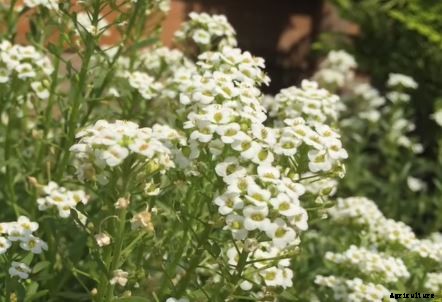
Il piccolo, i fiori delicati sbocciano continuamente dalla tarda primavera fino a quando un gelo duro non conclude efficacemente la stagione di crescita.
Un membro della famiglia delle Crocifere, dolce alyssum è classificato botanicamente come Alyssum Maritima. Sebbene il suo nome si riferisca quasi sempre ad esso, a volte è chiamato "candytuft".
Sweet alyssum è disponibile anche in rosa pastello, lavanda, e varietà viola. Una varietà perenne produce fiori gialli di forma simile.
Alyssum è naturale per i giardinieri pigri perché si auto-semina e inizierà a spuntare a metà primavera dopo che il terreno si è riscaldato un po'. Se vuoi fioriture anticipate, puoi avviarlo da seme in casa circa 4-6 settimane prima dell'ultimo gelo primaverile.
Pianta il candytuft in pieno sole fino all'ombra parziale. Nelle zone più calde della contea, apprezzeranno l'ombra parziale, soprattutto durante i mesi più caldi dell'estate. Le piante cresciute in parte o per lo più all'ombra cresceranno meno vigorosamente ma produrranno comunque una quantità rispettabile di fiori.
Nutrili regolarmente per mantenere i fiori in arrivo. È meglio usare un fertilizzante liquido o un tè fatto con letame o compost. Questo ti aiuterà a evitare di danneggiare le radici delle piante quando coltivi per incorporare fertilizzante granulare.
Alyssum inizia a sembrare leggy man mano che crescono e trarranno beneficio da una buona potatura a metà della stagione di crescita. Taglia le piante di circa la metà. Questo li costringerà a espandersi, e produrranno molti più fiori.
Il "dolce" nel dolce alyssum deriva dalla sua sottile fragranza. Come altri fiori sottilmente profumati, è meglio piantato vicino a un ingresso o un patio dove il suo delizioso profumo può essere apprezzato da tutti coloro che passano. Come tanti altri fiori bianchi, sembra emanare più profumo di notte.
Alyssum è una buona pianta da includere in un giardino al chiaro di luna ... ma questo è un altro post.
I coneflowers viola sono stati ampiamente utilizzati dai nativi americani per curare una varietà di malattie. Il suo nome botanico Echinacea purpurea deriva dal greco echinos (la loro parola per riccio), che si riferisce al centro spinoso del fiore, e il latino porpora, che si riferisce al suo colore rosso porpora.
Echinacea purpurea sono piante perenni che raggiungono un'altezza di 2 o 3 piedi. Sono spesso propagati per divisione delle radici, ma sono altrettanto facilmente avviati dal seme. Plants started from seed will bloom in October the first year and in July thereafter.
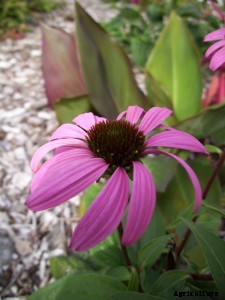
Plant echinacea in full sun to shade in fertile loamy soil, although they will grow in clay or sandy soil. They are relatively drought-resistant but will show signs of wilting if the soil becomes excessively dry.
Divide the plants by digging up and dividing the roots every 4 to 5 years.
Purple coneflowers attract a variety of different bees and butterflies. Goldfinches eat the mature seeds in early fall. Their pointy seed heads add a unique component to dried flower arrangements.
Native Americans treated everything from toothaches to colds to minor cuts, wounds, and burns. Rather than using the plant’s parts to make a healing tea, they chewed the roots, or the foliage was mashed up and made into a salve.
European settlers adopted the plant for medicinal purposes until it fell out of use in the 1930s. It has been re-discovered in recent years primarily as a cold and flu preventative, although its medicinal uses are far more extensive than that.
The juice of the roots was mixed with water and sprinkled on hot coals in traditional Native American “sweat lodges” for purification purposes. It is regarded today as an antibiotic and blood purifier that builds up the immune system. Some claim it provides immunity to a host of non-specific diseases.
Scientific research has not yet determined the exact compounds in purple coneflower that give it medicinal properties. Ancora, a long history of use in traditional folk medicine suggests that it is, infatti, effective as a medicinal herb.
Petunias are among the most popular flowers in urban home gardens, landscaped parks, and public areas everywhere. They are also featured in containers and hanging baskets in cities all over the country.
Petunias are also one of the newest garden flowers. They are native to South America and didn’t become well-known until the last part of the 19th century. It wasn’t until the 20th century that plant breeders began to select and breed them into the modern varieties we know today.
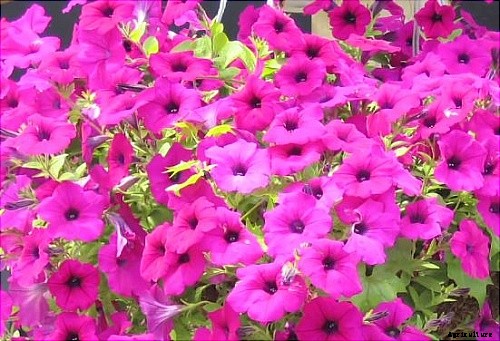
Petunias are collectively referred to today as Petunia x hybrida. They are thought to be a cross between Petunia axillaris (the night-scented white petunia) and Petunia integrifolia (a small violet-flowered variety). Petunias belong to the Solanaceae family, along with tomatoes, patate, e tabacco.
New classes of varieties of petunias have continued to be released, with the latest big addition in the early 1990s. There are now four main classes of petunias, suited to various uses, from garden specimens to ground covers to those with pendulous habits that cascade over the edges of window boxes or hanging baskets.
These classes of petunias include groundcover or “spreading” petunias, Grandiflora petunias, multiflora petunias, and multiflora petunias. Here’s a short description of each:
Grandiflora petunias. These produce large flowers that are at least three inches across and sometimes larger. They come in single- or ruffled double-flowered varieties. Most are upright plants that develop into large, foot-high mounds of flowers.
Groundcover or “spreading” petunias. This variety grows to only about 6 inches high but spread rapidly to cover an extensive area in a single growing season. They will quickly cover several square feet and are ideal for use in hillside gardens where quick coverage is important. These spreading varieties are stunningly planted in hanging baskets or window boxes because they cascade 2 to 3 feet over the edge of the container.
Milliflora petunias. These are compact, miniature plants producing large quantities of small perfect flowers that are only 1 to 1 1/2 inches in diameter. They are perfect for the front of the flower border or in containers, especially those near the entrances of buildings, where you can enjoy the flowers up close.
Multiflora petunias. This variety has the same growth habit as grandifloras, but they are more compact plants with small but more numerous flowers. Their flowers can be single or double, but the majority of varieties are single. They make an eye-catching display massed together in a single color in the garden.
Petunias need at least six hours of sun a day to produce the abundant blooms for which they’re famous. They will grow in partial shade but will produce fewer flowers. In the Deep South and the Southwest, petunias will be happier in partial shade.
Hollyhocks are one of those charming old-fashioned flowers grown by our grandmothers. They deserve a place in modern flower gardens, if only for their unusual upright habit that stands out among bushier perennials.
Native to Asia, it is thought that they are one of the oldest flowers in cultivation, grown by the ancient Chinese. Hollyhocks have been found in Stone Age burial sites.
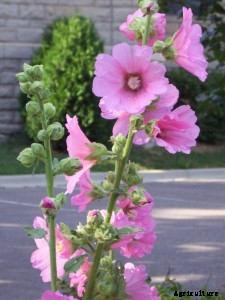
They derive their name from the Old English holi (holy) and hokke (mallow). Another early name for the plant is “St. Cuthbert’s cole.”
The leaves were formerly used as potherbs or in salads, best collected in the cool of early winter.
Most hollyhocks are classified as biennials, but a few perennial varieties and even a couple of annual varieties. The perennials are short-lived, anche se, often only living 2 to 3 seasons. They self-seed readily and will reappear in the garden even years after removing the mother plants.
Sow seeds of hollyhocks in mid to late summer. The plants will return in spring and bloom the following summer. They like full sun and moist, ricco, terreno ben drenato. Barely cover the seeds and keep them moist until they germinate. Cover the small plants before consistent freezing weather sets in.
Hollyhocks are susceptible to rust, and indeed it is the most often heard complaint about them. Removing the two lowest leaves shortly after they appear sometimes helps keep the rust from attacking them. You may be able to contain the rust to the lower leaves even if it does appear. Another option is to plant shorter flowers near them to hide the rust-infected lower leaves.
Water from below and provide plants with a lot of space in which to grow and breathe. Treat plants with fungicide if you cannot tolerate looking at the rust. These measures will sometimes keep rust from attacking. If it does appear, remove the affected leaves and put them in the trash. Do not add to the compost pile.
Hollyhocks are sometimes found growing on abandoned farms or along roadsides. They also make good additions to cottage-style gardens. They grow to heights ranging from one foot up to nine feet. The taller ones work great in the back of the flower garden, and the shorter varieties can be tucked in wherever the look of their spikes is desired.
Sunflowers are native to the Americas and have been cultivated for over 4, 000 anni. They were a major food source for the indigenous population and were even used medicinally.
Botanically called Helianthus from the Greek helios, meaning sun, and Anthus, meaning flower, sunflowers were adopted as a major crop by the Russians. Sunflower oil stays liquid at lower temperatures than animal fats, which was advantageous in their cold climate.
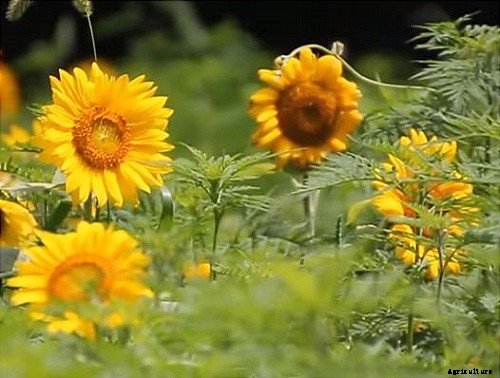
Victorians fell madly for sunflowers and used their likeness in art and architecture. Early American pioneers pounded the stalks to extract the fibers. The stalks were also used as kindling, and the seedless hulls were compressed into fire logs.
Plant sunflowers in mid-spring about 1 to 2 weeks before the date of your average last frost. They need full sun and aren’t overly fussy about soil fertility, although they benefit from a side dressing of compost.
Thin the seedlings, so the plants stand 12 to 18 inches apart, depending on the size of the variety at maturity. Many varieties will first produce a large basal flower and then branch out to produce many smaller blooms after the basal flower is cut. Some varieties naturally branch out, producing many smaller flowers.
Hybridizers have been busy, and sunflowers now come in various sizes and many colors in the yellow/gold/orange/rust family. They are spectacularly planted in various heights and colors as a theme garden.
Sunflowers reseed themselves prolifically and will come up every year, even if you don’t want them to. It goes without saying that small wildlife, such as birds and squirrels find them irresistible.
If you want to harvest the seeds for snacks or for planting next year, cover the flowers with a paper lunch bag when the seeds begin to ripen. Altrimenti, the local livestock will completely devour your sunflower crop.
The blooms of sunflowers turn to follow the sun’s path, beginning in the east in the morning and continuing throughout the day. They are one of the few flowers that follow this peculiar practice.
By all means, cut them and use them in bouquets. Their bright, cheery colors look good in any decor.
Fresh summertime sweet peppers are plentiful at supermarkets and farmer’s markets everywhere. Their bright colors beckon you to look, smell, and buy them.
Sweet peppers are known scientifically as Capsicum annum and are members of the nightshade family. They are usually plump and bell-shaped, featuring either 3 or 4 lobes, although other sweet peppers are more tapered and have no lobes.
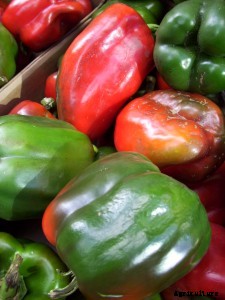
The four different types of sweet peppers are bell, Banana, cubanelle, and pimento. Like their hot relatives, they also originated in the Americas. The word “chile” is from an Aztec word, “nahuatl, ” although aboriginal South Americans called it “aji.” Archeological evidence shows that Peruvians have been eating wild peppers since about 7000 BC and have cultivated them since approximately 6100 BC.
Start sweet peppers from seed indoors about 6 to 8 weeks before the average date of your last spring frost—Harden off before transplanting to the garden, which should be done when you transplant your tomatoes. Sweet peppers will not grow well in cold, wet soil and do not grow when nighttime temperatures dip below 50°.
Space pepper plants 18 to 24 inches apart in rows 24 to 36 inches apart. For intensive spacing, plant 14 to 18 inches apart in all directions. Side dress with granulated fertilizer when planting and add a scoop of compost to the planting hole. Peppers thrive in well-drained fertile soil and need consistent moisture. Apply liquid fertilizer after the first round of infant peppers have set and continue to fertilize weekly throughout the growing season.
All peppers need consistent moisture to set fruit. Lack of this or drought can cause blossoms or even infant fruits to drop off the plant. Hot, dry winds and soil can prevent the fruit from forming in the first place.
If you are a smoker, wash your hands before handling pepper plants. It is possible to transmit the tobacco mosaic disease (if present in your cigarette tobacco) to your garden sweet peppers, as they are both members of the nightshade family.
Stuffed peppers are one of the most popular ways to serve summer’s bounty of fresh sweet peppers. Most cultures have their own recipes, but all usually feature a filling of rice and some type of meat or protein, along with their favorite herbs and spices. Many other recipes use peppers in many creative ways. Their use as an integral component in recipes has become almost as commonplace as onions and garlic.
Within 50 years of being brought back to Spain, sweet (and hot) peppers spread throughout Europe and the Mediterranean region. Soon after that, Portuguese explorers had successfully introduced peppers to Africa, India, Southeast Asia, Cina, e Giappone.
Sweet peppers are one of the most widely used vegetables/seasonings in the world.
Swiss chard is a green that grows well during the hot summer months, usually without turning bitter. Any bitterness will only be in the mature outer leaves and disappears when they are cooked. When sweltering summer weather passes, the large outer leaves will lose their bitterness, and they’ll begin to grow sweet and succulent again.
Thought to originate in Sicily, the original varieties of Swiss chard had white stems. Ancora, new varieties have been developed in recent years with stems of bright colors, such as the rainbow Swiss chard in the photo at right. Even the leaves can have a slight purple tinge.

Swiss chard was originally called “Swiss” because seed catalogs in the 19th century wanted to distinguish it from French spinach. Botanically it is called Beta vulgaris flavescens and is a member of the same family as beets. Essentially it’s a beet without a root.
Plant Swiss chard, rainbow or otherwise, in mid to late spring. Plant seeds 1/4 inch deep and an inch apart in rows 12 to 18 inches apart. When the young plants are about three inches high, thin to stand about 4 to 6 inches apart, plant them 6 to 8 inches apart in all directions for intensive spacing. It’s not overly fussy about the fertility of the soil.
If you’re a lazy gardener (like me), Swiss chard will be a good friend to your garden. It withstands neglect and will even grow during droughts.
You can start harvesting leaves of any size. You can add tender young leaves to salads or stir-fries. You should cut larger, more mature leaves from the outside of the plant, and the new leaves at the center of the plant should be left to mature.
Swiss chard will even grow in partial shade and still produce a respectable crop. It survives temperatures down into the ’20s. Even if the leaves outside the plant freeze, the inner leaves will still be intact and edible.
The entire plant is edible, but the stems need a longer cooking time than the leaves. interessante, American cooks primarily use the leaves, and European cooks primarily use the stems. I use the entire plant.
The stems have the texture of cooked celery and should, infatti, be cooked similarly. The leaves can be substituted in virtually any recipe calling for spinach, with a slightly longer cooking time.
Late summer is the time to start planting for fall harvests. Now is the time to plant vegetables that prefer to mature during cool weather.
Plant Pisum sativum—the English garden type along with edible-podded snow and snap varieties—in early to mid-August for harvesting in mid to late September.
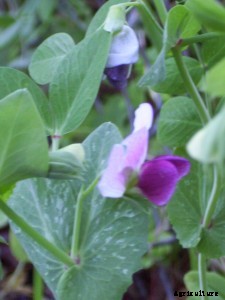
Plant peas in between the rows of corn in your garden. The corn will mature and be harvested long before the peas need the room. Another good place to plant fall peas is where lettuce or other greens were growing. These leafy crops deplete supplies of available nitrogen in the soil, and the roots of peas “fix” nitrogen into the soil.
This is a complicated scientific process that I’m not qualified to explain. Suffice it to say that it works. Once the plants are finished producing, leave their roots in the ground, and they will release the captured nitrogen into the soil, where it can be used by other plants that you subsequently grow in the same area.
When planting peas for fall, plant them almost twice as deep as spring-planted peas. This will help keep the seeds cool and also from drying out before they germinate. In ogni caso, keep them well-watered to avoid overstressing them and also mulch the soil to keep it cool.
Space the seeds about two inches apart and thin the seedlings to about four inches apart when they’re three inches high.
Snap peas and Oriental snow peas grow tall enough to require some support for them to climb upon. English garden peas only grow about 12 to 18 inches high and do not need such support.
The blossoms and new growth shoots of pea vines are also edible. Infatti, the seedlings that you thin are completely edible. Simply pinch off the roots and toss them into a salad or stir-fry.
Check your pea vines daily once they start producing. Edible podded peas are best eaten when the peas inside are just starting to swell. English garden peas, traditionally eaten when plump and succulent, can quickly become tough and woody if left too long on the vines.
When freezing weather kills off the vines, leave the roots in the soil. By spring, they will be nearly completely decomposed and ready to plant a crop that likes rich, well-fertilized soil, come pomodori, cetrioli, or melons.
Dusty Miller has grown annually in much of the temperate zones, but it’s technically a perennial. In Zone 7 and warmer, it will survive winters and is often planted with pansies in winter flower gardens.
You can find Dusty Miller available in several cultivars under the Latin name Senecio cineraria. The first name, Senecio, comes from the Latin “senex, ” which means old man. The second name, cineraria, means ashy gray in Latin.
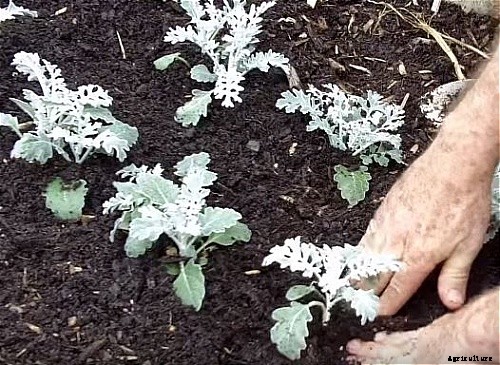
A more finely leafed variety is excellent to use in hanging baskets or any container. The lacy foliage really stands out when viewed up close.
Plant them in among your flowers for a shimmering backdrop to their bright colors. Dusty Miller prefers full sun to part shade so that you can plant them among virtually all blooming plants.
Native to the Mediterranean, Dusty Miller prefers sandy, terreno ben drenato. This is one member of the flower border that can withstand drought. It is excellent planted in window boxes that are beneath the eaves of your house and therefore do not receive much natural rainfall.
It isn’t bothered by many pests except the occasional aphid, which can be washed off with a strong spray from the hose. Do this on a cloudy day, so the fuzz on the leaves doesn’t get burned by the sun.
You can start them from seed indoors about eight weeks before your last spring frost, but they’re also widely available in spring as bedding plants. Space them 8 to 10 inches apart, and they will quickly grow to cover the area.
Their lacy, shimmery, gray foliage makes ideal plants to add to a white garden. Planted near patios or terraces, their soft gray color reflects nighttime exterior lights for a magical effect after dark.
Zinnias are native to the American Southwest and Mexico. They are members of the Asteraceae family. Its cultivars number in the hundreds since breeding and hybridizing begin in the 19th century.
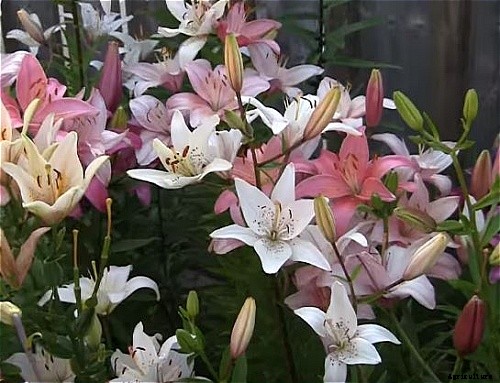
The more familiar species is Zinnia elegans, which includes most Zinnia cultivars, including double-flowered types that grow from one to three feet high. Zinnia linearis grows into a smaller, bushier plant and usually has single flowers. It is also more resistant to powdery mildew than Z. elegans. Hybrids between the two species show this resistance on plants that have traits of both parents.
Zinnias are one of the most popular seeds planted in school gardening projects. The seeds are large enough for little fingers to handle easily, and they germinate and grow quickly, blooming within a couple of months of sowing.
You can get a jump on the season by starting zinnias indoors under lights about 4 to 6 weeks before the average date of your last spring frost. Harden off plants gradually and transplant them into the garden. Dopotutto, the danger of frost is past when you plant your tomatoes outdoors.
Zinnias like full sun and soil rich in organic matter but loose and friable with good drainage. Their native home is in sandy soil, and they will not grow in heavy clay soils.
The scourge of zinnias is powdery mildew. All varieties can show signs of the disease, with those in the variety Zinnia linearis a little less susceptible. Space the plants the maximum distance recommended for the type you are growing. Don’t water afternoon as this lessens the chance of the foliage being wet after sundown. Se possibile, don’t water with an overhead sprinkler.
Remember to deadhead your zinnias by removing faded flowers, and they will continue to bloom until killed by frost. They are often one of the last flowers whose blooms still look good when other annuals have faded.
Zinnias make wonderful cut flowers. They last for a long time, and their wide range of colors makes them compatible with most other flower varieties.
The small varieties looked charming cut with short stems and placed in tiny vases or antique china teacups. Set them in unexpected places throughout the house.
Hydrangeas are those large, bush-type perennials with giant flower heads in either white, rosa, o blu. They’re also called “mophead” or “lacecap.”
Fossil records show that hydrangeas grew in North America between 40 and 70 million years ago and about 25 million years ago in Asia.
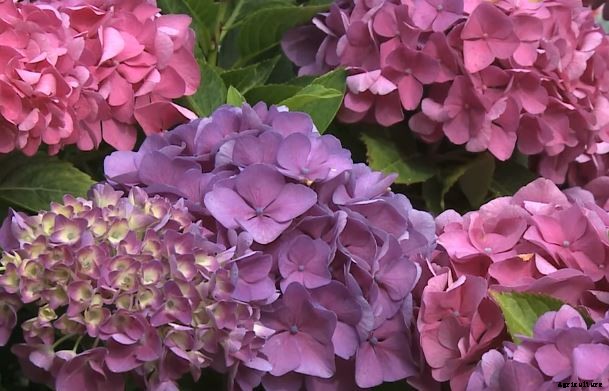
They bloom in mid to late summer and keep their flowers long after their leaves drop off in fall. The flowers looked spectacular on the plants for winter interest in the garden or cut and dried for indoor flower arrangements.
Plant hydrangeas in full sun to partial shade in moist, ricco, loamy soil that is well-drained. Add generous amounts of compost when transplanting and top dress with compost every spring.
The name “hydrangea” comes from the Greek words hydro (water) and angeion (vase) or “water vase.” The name doesn’t refer to the flowers; it refers to the shape of the seed capsule.
Hydrangeas are unusual in that you can change the color of their flowers by changing the pH of the soil in which they grow.
To make hydrangeas flowers pink like the ones in the photo above, raise the pH of their soil. Do this by adding dolomitic lime to the soil several times a year (available at garden supply stores). Follow the manufacturer’s instructions for correct quantities and add that amount to the soil around each plant in spring, summer, and fall.
Another thing to do to keep your hydrangeas blooming pink is to use a high phosphorus fertilizer (the second number on the fertilizer label—for example, 10-15-10).
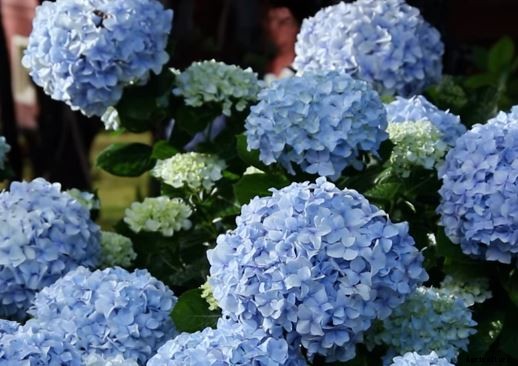
If blue hydrangeas are what you are after, add aluminum sulfate (a soil additive available at garden supply stores) to the soil they are growing. Mix 1 tablespoon aluminum sulfate with one gallon of water and apply a half-gallon of this mixture to the soil around each plant.
Attenzione: water your hydrangeas well the day before you do this so the roots can more easily take up the aluminum sulfate without getting burnt. Apply the aluminum sulfate mixture to the soil in spring, summer, and fall.
To help keep your hydrangeas blooming blue, use a low phosphorus fertilizer (the second number on the fertilizer label) and high in potassium (the third number on the fertilizer label). Per esempio, use a fertilizer labeled 25-5-30. Avoid using superphosphates or bone meal if trying for blue hydrangeas.
If your best efforts to turn hydrangeas either pink or blue result in them turning the opposite color, the culprit is most likely your water. Water with a high pH will tend to produce pink hydrangeas; conversely, water with a lower pH will produce blue hydrangeas—both despite soil amendments to the contrary.
Finalmente, hydrangeas planted near a concrete foundation or walk will tend to bloom pink because of the considerable amount of lime leaching out of the concrete, which raises the pH of the soil.
One last note on changing the color of hydrangeas:white hydrangeas will always be white and cannot be changed to pink or blue.
Read also:Flowers and Plants for Northern Gardens
Lilies come in several different varieties with blooming times from midsummer through early fall. Plant some of each variety for a continuous supply of blooms throughout the growing season.

Although you can plant lily bulbs in spring, fall is the best time for planting as it gives them time to develop a strong root system before breaking into vegetative growth the following spring. Potted lilies in active growth can be planted in your garden at any time during the growing season.
Lilies are grown from bulbs with fleshy overlapping scales with no protective covering. Plant them soon after purchasing and don’t allow them to dry out.
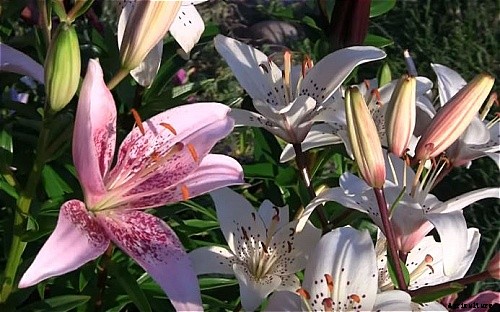
Plant them in well-drained soil in a site where water does not stand after rainfall. Dig down 12 inches and remove rocks. Add peat moss and compost to improve the soil and help with drainage. According to the manufacturer’s recommended quantities, add a little bone meal to the bottom of the hole and scratch it in with your garden claw.
A pleasing way to display lilies in the perennial garden is to plant them in groups of three or five bulbs, spacing the individual bulbs 8 to 12 inches apart. Space the groupings 3 to 5 feet apart. Small bulbs should be planted 2 to 4 inches deep and larger ones 4 to 6 inches deep, as measured from the top of the bulb up to the surface.
Spread organic mulch-like cocoa hulls over the bed. Just before the ground freezes for the winter, add a layer of protective mulch of evergreen boughs, hay, or fallen leaves.
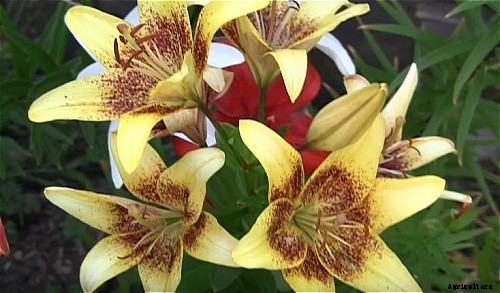
Asiatic lilies start the lily season when they bloom around midsummer. The picture above is of Asiatic lilies blooming right now in Zone 4. Most types of flowers face upward and have few markings on the petals—Hardy in Zones 4 to 9.
Trumpet lilies begin blooming at midsummer. They are named for their trumpet-shaped flowers and are hardy in Zones 5 to 9.
Tiger lilies bloom from midsummer on. They have freckled, pendulous blooms with petals that curve back on themselves. They multiply prolifically and will form large clumps in a few years. Each stem produces many flowers in warm colors, from golden yellow to orange, to red—Hardy in Zones 3 to 9.
Rubrum lilies bloom in late summer to early fall. They resemble Tiger lilies but come in cool colors from white to deep pink. Their blooms are sweetly fragrant—Hardy in Zones 4 to 9.
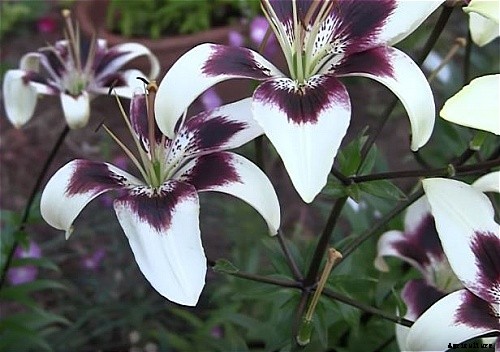
Oriental lilies start blooming in late July, with some varieties not coming into bloom until late August or September. They are intensely fragrant with flowers up to 10 inches across—Hardy in Zones 4 to 9.
Orienpet lilies are a cross between an Oriental and a Trumpet lily. They bloom from mid to late July into mid-August and can reach eight feet high. Flowers come in both warm and cool shades, with some varieties extremely fragrant. They prefer dappled sunlight or morning sun with afternoon shade—Hardy in Zones 4 to 9.
Plant a variety of lilies, so you have a continuous supply of blooms from midsummer through fall.
Honeysuckle vines, belonging to the Lonicera species, are easy to grow, heat-tolerant, vigorous, and nearly indestructible. They are commonly used to climb up a trellis, recinzione, or another framework. Less well-known is their use as a ground cover for erosion control.
Said to protect your garden from evil, honeysuckle is known as the “love bind” because it symbolizes a lover’s embrace with its clinging growth habit.
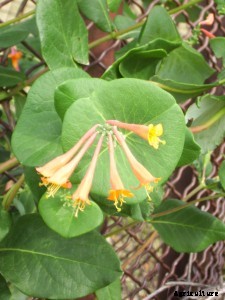
They prefer full sun but will tolerate partial shade. They are drought-resistant once established and only need supplemental fertilizer in early spring and again at midsummer.
Plant honeysuckle in early spring, when all danger of frost has passed. Prepare the planting area by adding peat moss and compost. Dig the soil to a depth of about 6 to 8 inches. Mulch well after planting. Honeysuckle like their leaves in the sun and their roots in the cool shade.
Prune for shape after they finish blooming but only prune lightly until the vines are in their third growing season.
Aphids love honeysuckle, and you’ll need to be vigilant in washing them off with a strong spray from your hose.
Notorious for its sweet scent, honeysuckle vines attract both bees and hummingbirds, who feast on the nectar deep within their elongated blossoms.
Honeysuckle will climb up anything with just a little help from you. Get the vines started climbing by loosely tying them to their supporting structure. They will soon grow and fill it in so much that the supporting structure will virtually disappear.
Folklore tells us that if you bring honeysuckle into your house, there will soon be a wedding. And if you sleep with a sprig of it under your pillow, you will dream sweet dreams.
Of your impending nuptials, no doubt.
Spring blooming lupines, Lupinus albus, were cultivated 4, 000 years ago by the Egyptians. In the Americas, Lupinus mutabilis were brought into cultivation 1, 500 years ago.
Although we think of lupines as flowers, they are grown as feed for livestock in many parts of the world. Because they grow well on poor, sandy soils and, infatti, improve the soil, lupines are often grown for soil improvement and followed by a more demanding crop, such as melon, Mais, or wheat.
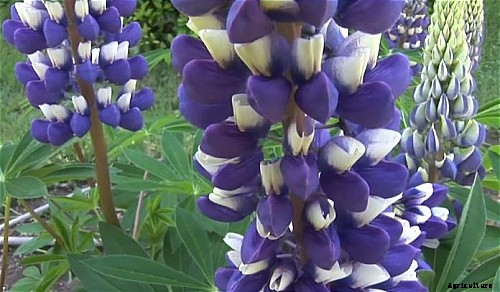
Romans used them medicinally for skin ailments and as an antidote for the bite of an asp, although there is no data on the latter’s effectiveness.
Lupines prefer slightly acidic soil that is well-drained and moderately fertile. They do best in full sun but will grow in partial shade.
Sow annual lupines from seed around the time of your last frost. They will bloom about two months later.
Perennial lupines are best sown from seed in autumn. Soak the seeds in warm water for a day before sowing. They will bloom in mid-spring. You can also start plants indoors about eight weeks before consistent frost-free weather in your area. Plant outside. After all danger of frost is past.
Space lupines about 10 to 12 inches apart. Water regularly and fertilize with a high phosphorous, low nitrogen fertilizer. (In other words, a low first and a high second number, such as a fertilizer labeled 5-25-10.)
Lupines come in blue, viola, rosa, giallo, e bianco. They will bloom over and over if you deadhead them by cutting off faded flowers.
Pliny, the Greek writer, and physician claim that the smoke of burnt lupines kills gnats.
I wonder if it works on mosquitoes.
Salvia is a popular flowering plant for urban gardens. With a combination of over 700 annual and perennial species, there’s a type of salvia out there for everyone.
They can prolifically reseed themselves, like the ones in the photo at left. These are growing in the cut-out area of a sidewalk around the installation of a telephone pole. They most likely blew in from the cultivated salvia growing in a flower bed a couple of houses down the street.
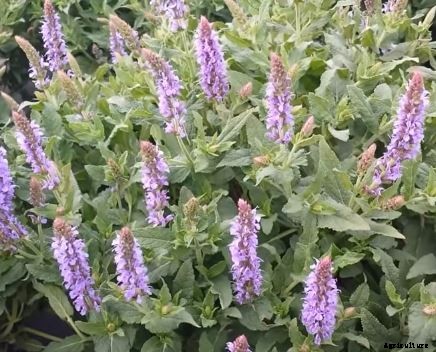
Although I don’t know the variety of this particular salvia, it is most likely one of the tender perennial varieties treated as annuals in temperate regions.
Salvia does best in full sun. Ovviamente, they’re not fussy about their soil, only that it should be well-drained.
If you’re planting salvia, you can direct seed it right in the garden in late spring. Sprinkle the seeds on top of the soil. Do not cover; press them in gently with your hand. Mist lightly after you plant them and then mist daily to keep them moist until they germinate.
You can also propagate them by root division, which is best done in spring.
They’re also one of the most popular bedding plants found at garden centers and farmer’s markets every spring.
Space salvia 10 to 20 inches apart, depending on the size at maturity of the variety you’re planting.
Although the red variety of salvia is often planted, the purple variety provides a cool contrast to the hot reds, oranges, and yellows of most summer-blooming flowers. And it reseeds itself.
In Minneapolis today, workers hoisted the last steel beam to the top of the new baseball stadium.
Attached to the steel beam was a pine tree.
The tradition goes back some 1200 years to the Vikings (somehow appropriate). Scandinavian builders topped off their buildings with a sheaf of grain for the horse of their beloved god, Odin. For his part, Odin was so pleased with this that he bestowed good luck on the future occupants.
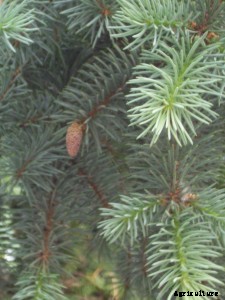
As the Vikings spread throughout (conquered) Europe, they brought their topping off practice with them. Britons and Germans substituted trees for the grain, and interestingly enough, the Scandinavians eventually switched to using a tree.
The tradition was brought to America by Scandinavian ironworkers, who promptly added an American flag. Infine, it became common for the workers to sign the beam before you set it in place.
Not only does raising a pine tree commemorate the building to the highest point of the structure, but it also celebrates doing so without serious injury to the workers.
Pine and evergreen have long symbolized hope to humanity. During the cold, buio, seemingly lifeless winter days, the pine and evergreen remain green and look alive.
Per la maggior parte, pine trees do not need pruning. If you do prune a pine, don’t remove whole branches; the tree may never recover. Ad esempio, if a branch is growing into a path, cut a few inches off the tip rather than the entire branch.
Evergreen shrubs and small trees are often pruned to maintain their size and shape in the landscape. June is the ideal time for this.
Ancora, prune sparingly. Only prune off the tips of the branches. If it is necessary to remove an entire branch, do not cut it off flush with the main trunk. Leave a quarter-inch stump.
If you have a large pine or evergreen which has overgrown its space and you’re tempted to cut off the bottom branches, do the tree and yourself a favor and have the tree removed.
Cutting off the lower branches of an evergreen removes the lowest level of support for snow-filled branches. Infine, starting at the bottom, the remaining branches will break under the weight of the snow.
Remove the tree and plant something that loves acid soil, like blueberries or rhododendrons.
Blueberries taste a lot better than pine cones anyway.
I captured a zucchini blossom this morning on a plant that’s barely bigger than a transplant. It’s actually the second one that opened. I missed the first flower—you can see it wilted in the background in the photo at left.
Zucchini, come on like gangbusters, and don’t let up until the weather cools in fall. Stories of grocery bags filled with zucchini that were left on neighbor’s doorsteps were circulating in the neighborhood a few years back, but no one came forward as the alleged recipient.
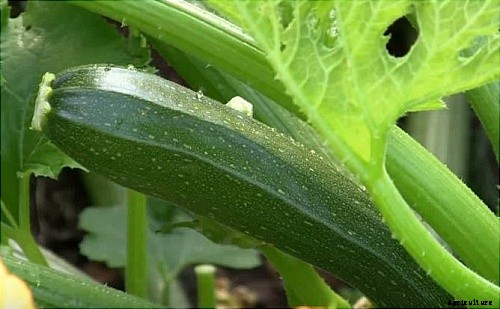
All squash are native to the Americas, but zucchini is a mutant or sport that originated in Italy. Its name comes from the Italian zucchino, which means “little squash.” Botanists called it Cucurbita pepo, a member of the same family as cucumbers and melons. In the United Kingdom and New Zealand, zucchini is referred to as “courgette, ” while Australians and Americans call it “zucchini.”
Whatever you call it, you have to call it versatile. You can serve zucchini cooked or raw, sweet or savory. Zucchini is grilled, fried, deep-fried, stuffed, or baked with an endless variety of spices and seasonings. And virtually everything you can do with the fruit of zucchini you can do with the blossom.
Infatti, one of the ways you can “temper” the amount of zucchini your plants produce is to harvest the blossoms. Stuff them, dip them in tempura batter and deep fry them. Cuocili al forno. Put them raw into salads. Use them as a filling for quesadillas.
Sometimes you can find a perfect zucchini blossom still attached to the tiny zucchini fruit at its base. These are much sought after by gourmets and pricey restaurants.
You grow zucchini the same way you grow cucumbers. Plant them in late spring. Dopotutto, the danger of frost has passed. Plant five or six seeds in “hills” of soil. When the plants are about two inches high, thin to the strongest two or three plants, this is best used for “bush” varieties of zucchini, which form a compact bush-like plant.
For varieties of zucchini that grow into a vine, it’s best to grow them vertically. Zucchini will climb a vertical trellis or net with just a little help from you. Vertical growing keeps the plants off the ground and makes it easier to see the fruits.
Make sure to harvest zucchini every day. Pick fruits before they reach six inches in length when they are the most tender and flavorful. If you miss a few and get a little large, peel them, seed them, grate them, and make zucchini bread. Or add a couple of cups of grated zucchini to any chocolate cake recipe.
Read also:Flower Meaning Perseverance – Magnolia
But try to resist leaving them on your neighbor’s doorstep.
Read also:How To Rebloom Orchids
